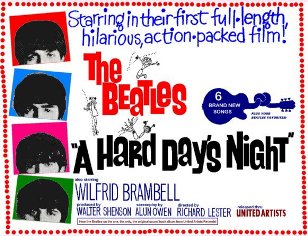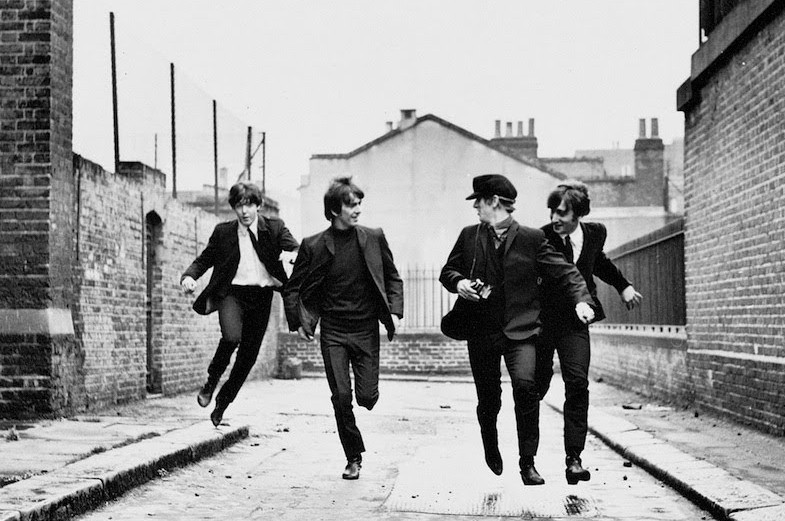
 Now, more than half a century later, there has never been a rock & roll film that has surpassed “A Hard Day’s Night.” Not only is it a great rock movie and a great time capsule showing how insane Beatlemania was at its height, but it is simply a great movie (having made many “100 Greatest Films” lists) that influenced many subsequent filmmakers and is credited with single-handedly inventing the music video.
Now, more than half a century later, there has never been a rock & roll film that has surpassed “A Hard Day’s Night.” Not only is it a great rock movie and a great time capsule showing how insane Beatlemania was at its height, but it is simply a great movie (having made many “100 Greatest Films” lists) that influenced many subsequent filmmakers and is credited with single-handedly inventing the music video.
The next time you watch this classic, here are some things you can watch for that you might have missed before.

- The film’s shooting title was “Beatlemania.” Who made the actual decision to change it to “A Hard Day’s Night” is in dispute, but all agree the phrase was originally created by Ringo after a grueling work session.
- United Artists was sure that the Beatlemania was just a passing fad. They authorized a very small budget ($500,000) and memos at the time show that the studio thought the film would lose money. They were really only interested in the soundtrack album (where they believed they would make up the money they lost on the film). That’s the main reason the film was shot in black and white.
- Those opening scenes, where the boys are being chased by rabid fans to and through Marylebone Rail Station in London? The boys really are running for their lives. The film company used genuine Beatle fans who actually were trying to get their hands on the Fab Four.
- Look closely and you’ll see that George falls during that chase and Ringo goes tumbling after him. There was no way to cut due to those screaming fans. So the lads have to pick themselves up and continue their mad dash.
- While the script seems at times to be ad-libbed, it was all scripted. Screenwriter Allun Owen spent several weeks with the Beatles and all concerned say he came away with an incredible knack for being able to mimic their cheeky style.
- One of the young schoolgirls on the train was Patti Boyd, who went on to become George Harrison’s first wife and later, Eric Clapton’s wife. She was also to inspire the songs “Something (In the Way She Moves)” and “Layla.”
 In the famous “Can’t Buy Me Love” scene (credited with being the very first rock video), John was not available for the filming and so a double was used for the aerial shots.
In the famous “Can’t Buy Me Love” scene (credited with being the very first rock video), John was not available for the filming and so a double was used for the aerial shots.- There is an “in” joke in the constant references to Paul’s grandfather as a “clean old man.” At that time, the actor playing John McCartney (Wilfred Bramell) played a junk man on British TV’s Steptoe and Son (the later American version was named Sanford and Son). As Steptoe, Bramell was constantly called a “dirty old man.” So the “clean old man” gags were funny to British audiences, but went right over the heads of American audiences.
- During the rapid fire press conference/cocktail party, asked what he calls his hairstyle, George replies, “Arthur.” That name was picked up and used as the name of an early trendy New York discotheque (pre-Studio 54).
- Don’t know if you’ll recognize him, but a very young Phil Collins is in the audience of kids at the televised concert that comes near the end of the film.
- Studio execs at United Artists in the States thought the Beatles’ accents would be incomprehensible to American audiences and asked that their real voices be replaced by voice actors with more “proper” British accents. Director Richard Lester declined their request.
- Where’s Paul’s solo scene? The other three Beatles all get short solo scenes: George with a TV producer, John with a dancer, and of course, Ringo going “adventuring.” But why no solo scene for Paul?
- Actually, there was. It was an encounter between Paul and an actress that happens while Paul is out looking for Ringo. The scene was shot but cut from the film because director Richard Lester felt it simply didn’t work. It came off as too stagey. Alas, the footage for this unused scene was destroyed by the studio in the days long before home video and bonus features were ever dreamed of. However, the scene did make it into the paperback novelization of the film and the actual script for it can be found here.
- The group’s name, “the Beatles,” is never said, even once, during the film. (It does appear on Ringo’s drum kit, the stage lighting during the concert and a helicopter at the end, but no one ever mentions their name out loud.)
Do yourself a favor and rent, buy or stream a copy of this classic soon.